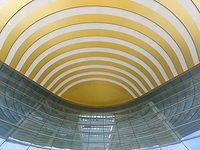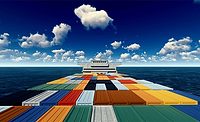Coil Coating Applications
The Next Frontier for Energy-Curable Technologies










Industrial coatings made with advanced polymers, pigments, and additives perform a variety of important functions, including UV protection, chemical and corrosion resistance, and durability that can extend the lifecycle of a product. When it comes to performance, however, the quality of the coating formulation is only half of the equation. Coatings have to be cured properly as well—with strict adherence to the specifications provided by the coatings manufacturer—for optimal protection performance and aesthetics.
Curing, or crosslinking, is the chemical process that enables a coating to harden and bond to a substrate. A good curing process is essential for chemical resistance, color, resiliency, and other important performance characteristics. However, curing methods vary based on the specific chemistry of the protective coating. Conventional liquid and powder coatings typically cure with air or heat, but alternative solutions exist that use radiant energy sources to initiate the cross-linking process instead.
Energy-curable coatings were introduced in the wood products industry more than 50 years ago. Due to innovations in formulations, processes, and equipment, these high-technology solutions are now used on substrates such as vinyl, composites, and even pre-painted metal.
Thanks to significant investments in research and development, a new frontier has emerged for these advanced solutions: coil coating applications. Energy-cure coatings are expected to produce revolutionary changes in coil-centered industries like building materials, appliances, and HVAC. These advancements will raise the bar for more sustainable, energy-efficient, high-performance solutions, including formulations that offer durability for exterior applications and broader gloss ranges.
What are Energy Curable Coatings?
The two primary types of energy-curable coatings are ultraviolet (UV) and electron beam (EB), each with their own performance attributes. While the curing mechanism varies between the two, they both convert liquid paints to solids that fully cure and bond with the substrate in seconds to form a hard, durable finish.
Unlike thermal curing that requires heat, energy curing is performed at or near ambient temperature using photons of light or electrons to polymerize materials onto a substrate. This method, often called cold curing, is attractive to manufacturers that use wood, plastic, and other heat-sensitive materials because these substrates can be damaged when exposed to the higher temperatures required to rapidly cure most conventional coatings. UV formulations are comprised of liquid monomers (small molecules), oligomers (a molecular complex comprised of a few monomer units), and additives with a small percentage of photoinitiators that convert light energy to chemical energy. When UV-curable formulations are exposed to electromagnetic radiation from UV lamps, photochemical processes are initiated that result in the rapid polymerization of the monomers and oligomers.
EB formulations also use liquid monomers, oligomers, and additives, but they do not require photoinitiators. These formulations are cured by an electron beam device that emits electrons at a controlled rate that rapidly polymerize the monomers and oligomers in the formulation. Like UV coatings, the technology requires no heat source to cure.
Both UV- and EB-curable solutions can be used on various substrates that can be rolled, such as paper, PVC foils, or coils, because curing is immediate. They can be applied with a variety of methods, including roller coating, curtain coating, spraying, and vacuum coating.
The performance, sustainability, and other advantages of UV- and EB-curable coatings, coupled with advancements in the technology, are making these solutions viable for a broader range of substrates and industries.
Sustainability Benefits Driving Transitions to UV/EB-Curable Solutions
One factor driving global growth in energy-curable coatings is rising interest in more sustainable products. Most conventional liquid paints contain solvents that dissolve and disperse ingredients such as pigments, resins, and additives. Energy-curable solutions allow manufacturers to use 100%-solid-content solutions that contain no solvents, which leads to low, or even no, VOC emissions, and lower flammability risks.
This class of coatings is also considered to be more energy efficient since curing is nearly instantaneous. Less energy is needed for drying from UV lamps or electron beams than conventional thermal drying ovens.
With increasing regulatory oversight of VOC emissions and efforts to lower energy consumption, UV/EB technologies appear poised to meet the current and future environmental challenges of our time, and grow in prominence in the coatings industry.
Gains in Costs, Time, and Efficiency
Manufacturing is driven by productivity, and ways to improve turnaround time and cost efficiency. The finishing process can play a significant role in these efforts. Conventional liquid coatings require time and temperature to cure. Typically, lower temperatures require more time to dry and cure the paint.
While the level of light or energy needed to cure UV/EB coatings varies depending on film thickness and chemistry type, these technologies contribute to higher productivity from faster finishing since no time is needed to preheat the substrate or for water or solvents to evaporate before curing.
Another advantage is that no thermal ovens are required for curing because the polymerization reaction takes place at room temperature, which can produce impressive cost and time savings. Additionally, UV/EB equipment is less capital intensive and has a more compact footprint than thermal ovens (Figure 1).

These alternative technologies cure in seconds or even faster with immediate conversion rates of 90% or more. Parts can be handled almost immediately for packing, storage, and shipping, which reduces the need for floor space to hold inventory at various stages of the finishing process.
In multi-layer systems, it is also possible to consider wet-on-wet application in order to further reduce the length of the line and increase productivity. With EB solutions, for instance, a single cure is possible with up to three different layers of wet-on-wet paint of 80 microns each. With EB technology, film opacity has a negligible impact on curing as the electrons are not absorbed by pigments in the way that UV radiation is. Thick, multi-layer coatings can even be done at high speed.
In contrast, UV curing for wet-on-wet application can be more challenging when the paint is not clear or transparent, as it is more difficult for photons of light to penetrate the paint.
Performance Advantages
Energy-cured coatings deliver on protective performance by offering exceptional hardness, scratch and chemical resistance, and high flexibility.
While energy-curable coatings were once considered to be brittle, that is no longer the case. In the technology’s early years, these coatings were ideal for flat surfaces that didn’t require “flexible” paint. The latest energy-cure formulations meet the requirements for flexible substrates, good bonding strength, and resistance to twisting and bending.
Because these coatings are made with 100%-solid content and do not contain water or solvents, these solutions maintain nearly the same film thickness before and after the cure, with virtually no loss in weight.
With modifications to formulations, processes, and curing equipment, sheen levels from deep matte to very-high gloss can be achieved. While both technologies offer distinct advantages, the decision between UV- or EB-curable coatings includes factors such as initial equipment start-up costs, application requirements, and ongoing operational costs.
What’s Next for Energy-Curable Innovation?
Wood manufacturing remains one of the primary industries for energy-cure technologies today, but that is changing quickly thanks to a growing global interest in more sustainable finishing solutions. Through investments in research and development, including pioneering work done by PPG, these advanced coatings are now available for a broader range of applications and industries.
Historically, the shape or design of the substrate was a major consideration in whether UV/EB technology was an option, as it was more suitable for flat, linear shapes. Today, new curing formulations, equipment, and processes are making the technology more applicable for complex 3D shapes, creating new opportunities in industries such as automotive and general finishing.
Interest among coil applicators is growing primarily due to energy-efficiency advantages, low-VOC content, and a lower carbon footprint via the elimination of high-temperature, gas-fired curing ovens. With energy curing, manufacturers of coil-coated products can expect to lower their processing costs significantly.
PPG’s Commitment to Energy-Curable Solutions and Innovations
The use of energy-curable coatings is growing steadily among manufacturers and coil applicators. With ongoing investments in R&D, newer generations of UV/EB-curable coatings and advancements in equipment will continue to drive adoption of these solutions across a wider range of industries and end-use applications.
Architectural panels made from coiled aluminum is one of the many emerging uses for energy-cured coatings.
PPG’s extensive history with UV/EB technologies is helping the global coatings company accelerate the development of new energy-curable coatings for coiled metal, including cutting-edge solutions that offer the durability and performance needed for exterior applications, and a wider range of gloss levels.
The Newest Energy-Curable Innovation
PPG was among the first to offer UV-curable solutions for the wood industry and remains a global leader in energy-cure technologies. Today, the company offers a wide range of 100%-solid waterborne and solventborne formulations, suitable for a wide range of industries including coil, automotive, packaging and specialty materials.
The newest products in the company’s energy-cure portfolio are PPG DURANEXT™ UV/EB coatings, an alternative to traditional coil coating systems. It is the company’s first UV/EB product family for metal.
PPG DuraNEXT solutions include a line of primers, backers, topcoats, and clearcoats for interior and exterior applications, and are engineered to maintain the finish durability and beauty of coil-coated products. With near-zero VOCs and instant, non-thermal curing, DuraNEXT UV/EB coatings are a sustainably advantaged product line with a lower carbon footprint than traditional thermally cured building product coatings.
The family of products includes an EB clearcoat, which offers excellent weather resistance, durability, and color/gloss retention. The technology is engineered for interior and exterior coil applications and is used over digitally printed inks to maintain their beauty and durability.
For more information, visit PPG's website here.
*All images courtesy of PPG.
Looking for a reprint of this article?
From high-res PDFs to custom plaques, order your copy today!











